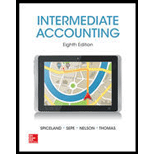
Intermediate Accounting w/ Annual Report; Connect Access Card
8th Edition
ISBN: 9781259546860
Author: J. David Spiceland
Publisher: McGraw-Hill Education
expand_more
expand_more
format_list_bulleted
Question
Chapter 10, Problem 10.23Q
To determine
Natural resources:
Natural resources are known as wasting assets. It consists of standing timber and underground deposits of minerals, gas, gold mines, and oil wells that requires extraction of resource.
To Explain: The difference between the successful efforts and the full-cost methods of accounting for oil and gas exploration costs.
Expert Solution & Answer
Want to see the full answer?
Check out a sample textbook solution
Students have asked these similar questions
None
Financial accounting
The total monthly fixed manufacturing cost ? General accounting
Chapter 10 Solutions
Intermediate Accounting w/ Annual Report; Connect Access Card
Ch. 10 - Prob. 10.1QCh. 10 - Prob. 10.2QCh. 10 - Prob. 10.3QCh. 10 - Prob. 10.4QCh. 10 - Prob. 10.5QCh. 10 - Prob. 10.6QCh. 10 - When an asset is acquired and a note payable is...Ch. 10 - Explain how assets acquired in exchange for equity...Ch. 10 - Prob. 10.9QCh. 10 - Prob. 10.10Q
Ch. 10 - Prob. 10.11QCh. 10 - Identify the two exceptions to valuing property,...Ch. 10 - In what situations is interest capitalized?Ch. 10 - Define average accumulated expenditures and...Ch. 10 - Explain the difference between the specific...Ch. 10 - Prob. 10.16QCh. 10 - Prob. 10.17QCh. 10 - Explain the accounting treatment of costs incurred...Ch. 10 - Explain the difference in the accounting treatment...Ch. 10 - Prob. 10.20QCh. 10 - Prob. 10.21QCh. 10 - Prob. 10.22QCh. 10 - Prob. 10.23QCh. 10 - Acquisition cost; machine LO101 Beavert on Lumber...Ch. 10 - Prob. 10.2BECh. 10 - Prob. 10.3BECh. 10 - Cost of a natural resource; asset retirement...Ch. 10 - Asset retirement obligation LO101 Refer to the...Ch. 10 - Prob. 10.6BECh. 10 - Prob. 10.7BECh. 10 - Prob. 10.8BECh. 10 - Prob. 10.9BECh. 10 - Prob. 10.10BECh. 10 - Prob. 10.11BECh. 10 - Nonmonetary exchange LO106 Refer to the situation...Ch. 10 - Nonmonetary exchange LO106 Refer to the situation...Ch. 10 - Prob. 10.14BECh. 10 - Prob. 10.15BECh. 10 - Research and development LO108 Maxtor Technology...Ch. 10 - Prob. 10.1ECh. 10 - Acquisition cost; equipment LO101 Oaktree Company...Ch. 10 - Prob. 10.3ECh. 10 - Prob. 10.4ECh. 10 - Prob. 10.5ECh. 10 - Prob. 10.6ECh. 10 - Prob. 10.7ECh. 10 - Prob. 10.8ECh. 10 - Prob. 10.9ECh. 10 - Acquisition costs; noninterest-bearing note ...Ch. 10 - Prob. 10.11ECh. 10 - Prob. 10.12ECh. 10 - Prob. 10.13ECh. 10 - Prob. 10.14ECh. 10 - Prob. 10.15ECh. 10 - Prob. 10.16ECh. 10 - Nonmonetary exchange LO106 [This is a variation...Ch. 10 - Prob. 10.18ECh. 10 - Nonmonetary exchange LO106 [This is a variation...Ch. 10 - Prob. 10.20ECh. 10 - Prob. 10.21ECh. 10 - Prob. 10.22ECh. 10 - FASB codification research LO101, LO106, LO107,...Ch. 10 - Prob. 10.24ECh. 10 - Prob. 10.25ECh. 10 - Prob. 10.26ECh. 10 - Prob. 10.27ECh. 10 - Prob. 10.28ECh. 10 - Prob. 10.29ECh. 10 - Prob. 10.30ECh. 10 - Prob. 10.31ECh. 10 - Prob. 10.32ECh. 10 - Prob. 10.33ECh. 10 - Prob. 10.34ECh. 10 - Prob. 10.35ECh. 10 - Prob. 1CPACh. 10 - Prob. 2CPACh. 10 - Prob. 3CPACh. 10 - Prob. 4CPACh. 10 - Prob. 5CPACh. 10 - Prob. 6CPACh. 10 - Prob. 7CPACh. 10 - Prob. 8CPACh. 10 - Prob. 9CPACh. 10 - Prob. 10CPACh. 10 - Prob. 1CMACh. 10 - Prob. 2CMACh. 10 - Prob. 3CMACh. 10 - Prob. 10.1PCh. 10 - Prob. 10.2PCh. 10 - Prob. 10.3PCh. 10 - Prob. 10.4PCh. 10 - Acquisition costs; journal entries LO101, LO103,...Ch. 10 - Prob. 10.6PCh. 10 - Prob. 10.7PCh. 10 - Prob. 10.8PCh. 10 - Prob. 10.9PCh. 10 - Prob. 10.10PCh. 10 - Prob. 10.11PCh. 10 - Prob. 10.12PCh. 10 - Judgment Case 101 Acquisition costs LO101, LO103,...Ch. 10 - Prob. 10.2BYPCh. 10 - Judgment Case 10–3
Self-constructed...Ch. 10 - Judgment Case 104 Interest capitalization LO107...Ch. 10 - Prob. 10.6BYPCh. 10 - Prob. 10.7BYPCh. 10 - Judgment Case 108 Research and development LO108...Ch. 10 - Prob. 10.9BYPCh. 10 - Prob. 10.11BYPCh. 10 - Prob. 10.12BYPCh. 10 - Prob. 10.13BYPCh. 10 - Prob. 10.14BYPCh. 10 - Prob. 10.15BYPCh. 10 - Prob. 10.16BYPCh. 10 - Prob. 10.17BYP
Knowledge Booster
Similar questions
arrow_back_ios
SEE MORE QUESTIONS
arrow_forward_ios
Recommended textbooks for you
 College Accounting, Chapters 1-27AccountingISBN:9781337794756Author:HEINTZ, James A.Publisher:Cengage Learning,
College Accounting, Chapters 1-27AccountingISBN:9781337794756Author:HEINTZ, James A.Publisher:Cengage Learning,



College Accounting, Chapters 1-27
Accounting
ISBN:9781337794756
Author:HEINTZ, James A.
Publisher:Cengage Learning,
